The cork insulation market is valued at USD 0.7 billion in 2025 and is projected to reach USD 1.1 billion by 2035, expanding at a CAGR of 3.9% during the forecast period. Growth is supported by increasing adoption of eco-friendly insulation materials, rising focus on energy-efficient construction, and regulatory encouragement for sustainable building practices.
From 2025 to 2030, the market is expected to expand gradually from USD 0.7 billion to USD 0.9 billion. This growth phase is supported by the strong uptake of expanded cork insulation boards, which hold a leading 46.8% share in 2025, and by their wider use in residential and commercial retrofitting projects. Demand is further reinforced by the acoustic insulation advantages of cork, alongside its recyclability and alignment with green building certifications.
Between 2030 and 2035, the market is projected to advance from USD 0.9 billion to USD 1.1 billion, reflecting steady but meaningful expansion. During this phase, adoption strengthens across premium green building projects and industrial applications, as cork becomes more cost-competitive against synthetic alternatives. Long-term durability, lower replacement cycles, and carbon-negative credentials are expected to secure cork’s role as a sustainable insulation choice.
Regionally, North America, Asia-Pacific, and Europe lead the market, with North America driving demand in retrofitting, Asia-Pacific benefitting from rapid urbanization and government-backed green initiatives, and Europe continuing to lead due to stringent environmental regulations.
.
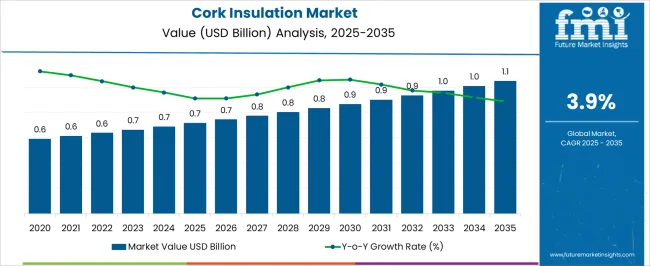
| Metric | Value |
|---|---|
| Cork Insulation Market Estimated Value in (2025 E) | USD 0.7 billion |
| Cork Insulation Market Forecast Value in (2035 F) | USD 1.1 billion |
| Forecast CAGR (2025 to 2035) | 3.9% |
The cork insulation market is experiencing notable growth driven by increased demand for sustainable and efficient insulation materials in the construction industry. Growing awareness of environmental impact and energy conservation has pushed builders and architects to favor eco-friendly products like cork.
Advancements in cork processing have enhanced its insulating properties, making it a competitive alternative to traditional insulation materials. The rise in green building certifications and government incentives for energy-efficient construction are further fueling market expansion.
Additionally, cork’s natural resistance to moisture, fire, and pests has made it a preferred choice in various climatic conditions. The trend toward healthier indoor environments and soundproofing solutions is also supporting cork insulation adoption. Market growth is expected to continue, with segments like expanded cork insulation boards, thermal insulation, and interior usage leading due to their strong performance and versatility.
Segments: by product type, expanded cork insulation boards, spray-applied cork coating, cork granules, and others (cork-based insulation mats, etc.); by insulation type, thermal, acoustic, fire-resistant, and others (moisture, etc.); by usage, interior, exterior, cavity wall, and others (underfloor, etc.); by construction type, new construction and renovation/retrofit; by end use, residential, commercial, and industrial; by sales channel, direct sales and indirect sales; by region, North America, Europe, Asia-Pacific, Latin America, and Middle East & Africa.
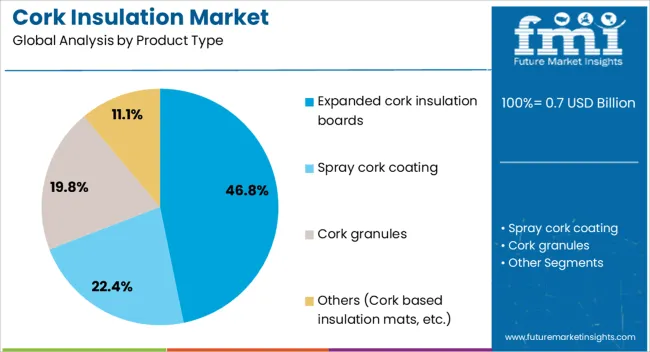
Expanded cork insulation boards are expected to hold 46.8% of the market revenue in 2025, establishing themselves as the leading product type. This segment’s growth is attributed to the boards’ enhanced density and superior thermal resistance compared to other cork products.
Their ease of installation and structural stability have made them a popular choice for both residential and commercial buildings. The segment benefits from cork’s renewable sourcing and low environmental footprint, which align with sustainable construction practices.
As demand for green building materials increases, expanded cork insulation boards continue to gain traction as a reliable and eco-friendly insulation solution.
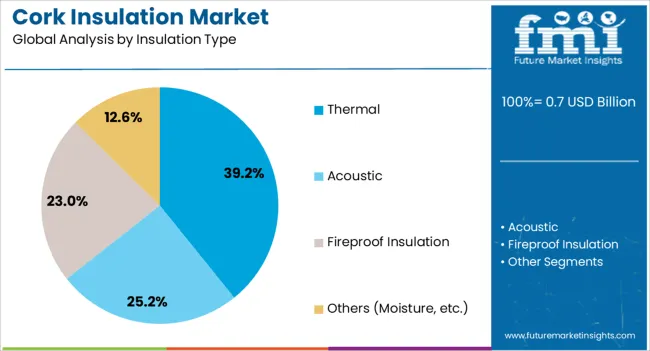
The thermal insulation segment is projected to contribute 39.2% of the cork insulation market revenue in 2025, maintaining its position as the dominant insulation type. Growth in this segment is driven by the need for energy-efficient buildings that reduce heating and cooling costs.
Cork’s excellent thermal performance helps maintain comfortable indoor temperatures, making it an effective insulator across diverse climates. Increasing energy regulations and standards worldwide have encouraged the use of thermal insulation materials in new construction and renovation projects.
The natural properties of cork, such as breathability and moisture regulation, add to its appeal in thermal applications, supporting sustained segment growth.
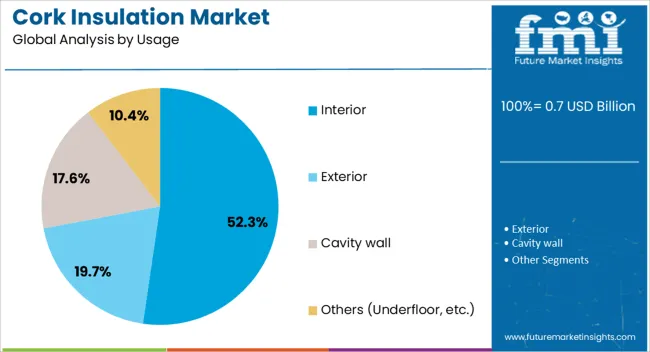
The interior usage segment is anticipated to account for 52.3% of the cork insulation market revenue in 2025, reflecting strong demand for cork insulation in walls, ceilings, and floors. Interior applications benefit from cork’s aesthetic qualities, flexibility, and acoustic insulation capabilities.
Architects and designers prefer cork for its natural look and ability to enhance indoor comfort by reducing noise and thermal transfer. Additionally, interior use is favored for retrofit projects aiming to improve energy efficiency without significant structural changes.
The segment’s growth is supported by increased residential and commercial building renovations, where sustainable insulation solutions are prioritized. As building standards evolve toward eco-friendly and health-conscious materials, the interior usage segment is expected to maintain its market lead.
Cork insulation is gaining momentum across construction, packaging, and specialty industries. Regulatory support, competitive differentiation, and multi-sector applications reinforce its long-term growth trajectory.
Cork insulation demand has been strongly influenced by the construction and housing industry, where its natural thermal resistance and acoustic dampening properties are being preferred over synthetic options. Residential and commercial builders favor cork due to its long life, adaptability, and natural resilience against fire and moisture. Retrofitting projects in Europe and North America have supported steady replacement cycles, while premium housing in Asia-Pacific has created new opportunities. The unique cellular structure of cork provides both insulation and soundproofing, making it highly suitable for apartments, offices, and schools. With building regulations increasingly favoring natural and recyclable materials, cork insulation has become a preferred solution for developers seeking long-term efficiency and comfort.
The competitive dynamics of the cork insulation industry are shaped by global producers and regional suppliers offering varied product formats. Companies are focusing on expanding portfolios with improved moisture resistance, higher compressive strength, and enhanced thermal conductivity. Differentiation has been pursued through innovations in panel formats, flooring applications, and wall insulation boards, enabling wider utility across residential and industrial construction. Regional suppliers compete by offering affordable cork boards tailored for small-scale projects, while larger manufacturers leverage branding and certification to capture premium demand. As competition from mineral wool and synthetic foams persists, cork’s eco-origin and durability remain strong differentiators, ensuring consistent demand among informed buyers.
Government regulations and building codes have been critical in shaping the cork insulation market. Stricter energy efficiency laws across Europe and parts of North America have encouraged developers to adopt high-performance natural materials. Energy labeling systems and incentives for green-certified buildings have favored the inclusion of cork, particularly in public infrastructure and multi-family housing. Regulations requiring lower emissions during building operations have indirectly increased cork usage by promoting thermally efficient structures. In emerging regions, governments are funding programs to encourage eco-friendly housing, which has created new entry points for cork. Regulatory pressure, coupled with consumer preference for safe, fire-resistant, and recyclable insulation, is expected to further drive adoption in diverse applications.
Beyond construction, cork insulation is witnessing strong growth in packaging, transportation, and specialty industries. Its lightweight, resilient, and vibration-dampening properties make it suitable for protective packaging of electronics, pharmaceuticals, and fragile goods. In the industrial sector, cork insulation panels are applied in cold storage facilities and food processing plants due to their moisture resistance and thermal stability. Automotive and aerospace applications are also increasing, where cork is used as a sound barrier and lightweight thermal lining. Manufacturers are investing in tailored product variants to serve these segments, diversifying revenue streams beyond construction. This expansion into specialty uses strengthens cork’s positioning as a versatile, high-value insulation material across global markets.
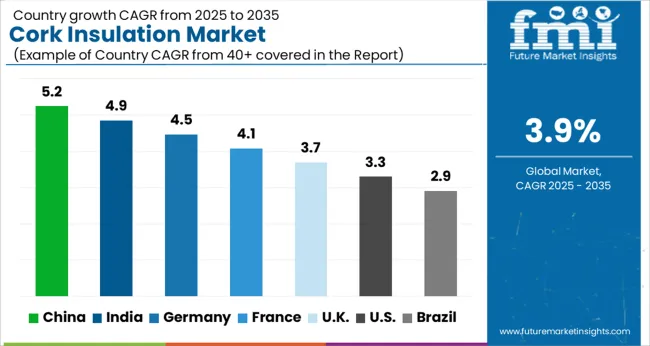
The cork insulation market is projected to grow globally at a CAGR of 3.9% between 2025 and 2035, supported by construction retrofits, acoustic insulation demand, and packaging adoption across multiple industries. China leads with a CAGR of 5.2%, driven by premium residential projects, rising infrastructure investments, and demand for natural insulation in urban redevelopment. India follows at 4.9%, supported by government-backed housing programs, wider use in affordable housing, and growing preference for recyclable insulation in commercial spaces. France posts 4.1%, benefitting from strong building regulations, retrofitting programs, and demand for acoustic insulation in high-density housing. The United Kingdom grows at 3.7%, aided by renovations of older housing stock, energy-efficient upgrades, and expanded demand from premium office spaces, while the United States records 3.3%, shaped by steady commercial retrofits, niche packaging applications, and gradual acceptance in residential projects. The analysis covers over 40 countries, with these five serving as benchmarks for capacity planning, raw material sourcing strategies, channel expansion, and innovation priorities in the global cork insulation industry.
China is projected to record a CAGR of 5.2% during 2025–2035, above the global baseline of 3.9%. Demand will be propelled by premium residential towers, acoustic upgrades in Grade A offices, and stricter fire performance expectations in public buildings. Retrofit activity in tier-one cities is boosting wall and floor applications, while integrated cork underlayment is gaining traction in mixed-use developments for footfall noise control. Import channels from Portugal are being balanced with local finishing lines to shorten lead times and stabilize pricing. Specifier education by leading distributors is improving conversion from mineral wool in interior partitions where impact sound ratings matter most. Procurement teams prefer cork boards and agglomerated sheets for stable R-values and long service life in humid coastal climates.
India is expected to post a CAGR of 4.9% during 2025–2035, comfortably above the global average. Growth is supported by metro rail station fitouts, hospital expansions, and premium housing where low VOC interiors and superior acoustics are prioritized. Builders in warm regions are adopting cork as a thermal break under tile and engineered wood, improving comfort without major structural changes. Hospitality chains are specifying cork core doors and wall panels to lift sound transmission class scores, which improves guest experience. Imported blocks are being converted domestically into tiles and boards, reducing costs. Channel partners are widening presence beyond metros to tier-two construction clusters, which broadens access for mid-scale developers seeking differentiated finishes with measurable performance gains.
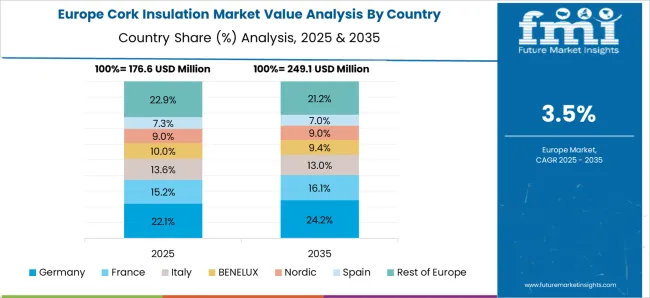
France is projected to grow at a CAGR of 4.1% during 2025–2035, slightly above the world rate. Public procurement rules that value fire performance and indoor air quality are favoring cork in schools, libraries, and municipal offices. Apartment retrofits in dense districts increasingly specify cork underlay to mitigate structure-borne noise without heavy floor buildup. France’s heritage refurbishments often require reversible, low-moisture solutions, a niche that suits cork boards behind plaster systems. Wholesalers report steady mix shift toward higher density sheets for improved compressive strength in floor systems. Architects prefer cork composite panels where thin build is required yet a meaningful drop in impact noise must be achieved. This mix of policy, acoustic needs, and refurbishment complexity keeps France on a steady upward path.
The United Kingdom is forecast to post a CAGR of 3.7% during 2025–2035, near the global mean of 3.9%. Between 2020–2024, the UK cork insulation market grew at about 2.6%, a period shaped by cautious post-pandemic project pacing, contractor preference for familiar materials, and import cost spikes. The step-up to 3.7% for 2025–2035 stems from faster retrofit cycles in pre-1990 housing, landlord upgrades to improve acoustic comfort, and better distributor inventory that reduces project delays. Data points support the shift: retrofit share in volumes is estimated to rise from roughly 42% to 50% by 2030, cork underlay adoption in multi-family projects is trending higher, and landed cost pressure has eased with broader supplier bases. Together, these factors push the UK toward steadier, more predictable adoption across residential and light commercial jobs.
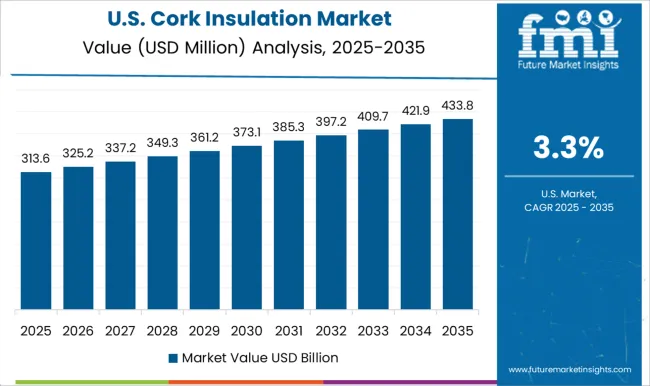
The United States is expected to record a CAGR of 3.3% during 2025–2035, modest yet durable. Uptake centers on niche segments where acoustic criteria are decisive, including multifamily corridors, recording suites, boutique hotels, and educational facilities. Designers value cork for consistent impact insulation class improvements under engineered wood and LVT, delivering comfort without thick assemblies. Cold-storage and food facilities adopt cork boards for thermal stability in areas with frequent washdowns. Distribution partnerships with specialty flooring houses are improving availability, while building owners evaluate lifecycle cost benefits from reduced callbacks on noise complaints. Competing materials remain strong, though cork secures wins where thin build, sound control, and fire performance must be balanced in one package.
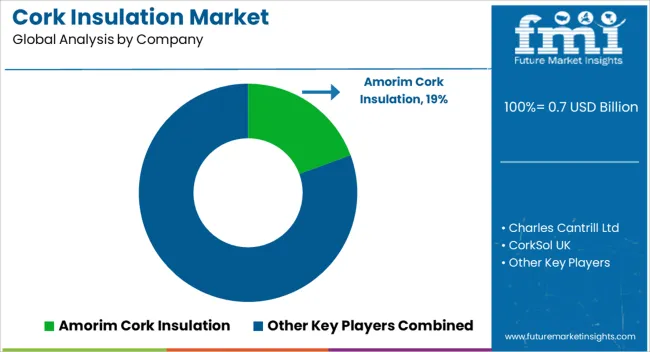
The cork insulation market features a diverse group of established manufacturers, regional specialists, and niche providers catering to residential, commercial, and industrial insulation needs. Amorim Cork Insulation leads globally with a comprehensive portfolio of cork-based thermal and acoustic solutions, supported by large-scale production in Portugal and global distribution.
Charles Cantrill Ltd maintains a strong reputation in the UK through specialized cork products tailored for construction and craft applications. CorkSol UK focuses on innovative spray-applied cork coatings, targeting energy-efficient retrofits and external wall insulation. Divine Cork emphasizes natural cork boards and panels, appealing to eco-conscious buyers in residential and hospitality projects. Isocor offers versatile cork solutions designed for soundproofing and flooring, expanding presence in Europe.
Jelinek Cork Group leverages its global legacy with extensive cork product lines for both insulation and decorative uses. MAPEI integrates cork within its broader building solutions portfolio, reinforcing its position in sustainable construction materials. MaryLand Cork Company, Inc. supplies cork insulation panels across North America, with a focus on consistent quality and tailored specifications. ThermaCork builds its presence with 100% natural cork insulation products, catering to architects and builders seeking durable, recyclable materials.
Ty-Mawr Lime Ltd specializes in traditional and natural building products, offering cork-based insulation solutions for heritage and restoration projects. VIPEQ HISPANIA provides cork coatings and insulation systems tailored for the Spanish and Latin American markets. WE Cork Inc. serves North America with a wide range of cork flooring, wall panels, and insulation boards, strengthening supply options for distributors and contractors.
| Item | Value |
|---|---|
| Quantitative Units | USD Billion |
| Product Type | Expanded cork insulation boards, Spray cork coating, Cork granules, and Others (Cork based insulation mats, etc.) |
| Insulation Type | Thermal, Acoustic, Fireproof Insulation, and Others (Moisture, etc.) |
| Usage | Interior, Exterior, Cavity wall, and Others (Underfloor, etc.) |
| Construction Type | New construction and Renovation/retrofit |
| End Use | Residential, Commercial, and Industrial |
| Sales Channel | Direct sales and Indirect sales |
| Regions Covered | North America, Europe, Asia-Pacific, Latin America, Middle East & Africa |
| Country Covered | United States, Canada, Germany, France, United Kingdom, China, Japan, India, Brazil, South Africa |
| Key Companies Profiled | Amorim Cork Insulation, Charles Cantrill Ltd, CorkSol UK, Divine Cork, Isocor, Jelinek Cork Group, MAPEI, MaryLand Cork Company, Inc., ThermaCork, Ty-Mawr Lime Ltd, VIPEQ HISPANIA, and WE Cork Inc. |
| Additional Attributes | Dollar sales, share, regional growth hotspots, pricing trends, competitive positioning, regulatory influence, distribution networks, retrofit demand, acoustic insulation adoption, product innovations, and forecasted CAGR to guide expansion and investment focus. |
The global cork insulation market is estimated to be valued at USD 0.7 billion in 2025.
The market size for the cork insulation market is projected to reach USD 1.1 billion by 2035.
The cork insulation market is expected to grow at a 3.9% CAGR between 2025 and 2035.
The key product types in cork insulation market are expanded cork insulation boards, spray cork coating, cork granules and others (cork based insulation mats, etc.).
In terms of insulation type, thermal segment to command 39.2% share in the cork insulation market in 2025.






Full Research Suite comprises of:
Market outlook & trends analysis
Interviews & case studies
Strategic recommendations
Vendor profiles & capabilities analysis
5-year forecasts
8 regions and 60+ country-level data splits
Market segment data splits
12 months of continuous data updates
DELIVERED AS:
PDF EXCEL ONLINE
Cork Packaging Market Insights – Growth & Forecast 2024-2034
Global Wine Cork Market Outlook – Growth, Trends & Forecast 2025–2035
Crown Cork Market Trends & Industry Growth Forecast 2024-2034
Electric Corkscrew Market
Insulation Tester Market Size and Share Forecast Outlook 2025 to 2035
Insulation Films Market Size and Share Forecast Outlook 2025 to 2035
Insulation Paper Market Size and Share Forecast Outlook 2025 to 2035
Insulation Market Size and Share Forecast Outlook 2025 to 2035
Insulation Coatings Market Size and Share Forecast Outlook 2025 to 2035
Insulation Boards Market Size and Share Forecast Outlook 2025 to 2035
Insulation Testing Instrument Market Size and Share Forecast Outlook 2025 to 2035
OEM Insulation Market Size and Share Forecast Outlook 2025 to 2035
Pipe Insulation Films Market Size and Share Forecast Outlook 2025 to 2035
Thin Insulation Market Size and Share Forecast Outlook 2025 to 2035
Pipe Insulation Market Size and Share Forecast Outlook 2025 to 2035
Cold Insulation Materials Market Size and Share Forecast Outlook 2025 to 2035
Pipe Insulation Products Market Size and Share Forecast Outlook 2025 to 2035
Wool Insulation Market Size and Share Forecast Outlook 2025 to 2035
Cold Insulation Market Growth - Trends & Forecast 2025 to 2035
HVAC Insulation Market Trends & Forecast 2025 to 2035

Thank you!
You will receive an email from our Business Development Manager. Please be sure to check your SPAM/JUNK folder too.
Chat With
MaRIA